Did you know that Ssam (Korean lettuce wraps) can be made with a whole variety of greens? Not just red or green lettuce? Each leaf has different flavors and health benefits so learn about how to enjoy the most delicious and healthy version.
What is Ssam?
Ssam 쌈 means ‘wrapped’ and in food, it means to make lettuce wraps with any or all of the following: grilled meats, fish, rice, ssamjang and pickled veggies like kimchi or jangahjji inside. Not only is this a delicious way to enjoy grilled meats or fish but it is also a fantastic way to balance out the heavy fatty flavor of the meats. Also, by adding these greens in, you can add a very high anti-oxidant rich vegetable in your meal.
How to eat Korean Lettuce Wraps?
There’s is no right or wrong way to eat ssam. You find whatever combination tastes delicious to you. Some like to wrap everything with rice and some say adding rice makes you full so they don’t. I like having rice in it because it just helps to break up the other strong flavors. It’s just like in Western cuisine, everything tastes better when you eat with bread.
Here’s a quick formula that I came up with that you may enjoy – just try a combination of below:
Leafy vegetable (1 or more) + rice + protein + banchan + ssamjang + raw garlic + green chili
- Protein – bulgogi, kalbi, pork belly, grilled meats or fish like sardines or eel
- Banchan – sweet and sour banchan like museangche, jangahjji adds great accent
Remember you can certainly combine different leafy greens. I like to do lettuce + perilla + crown daisies as the most basic combo. If not, I try all the other vegetable leaves I list below.
What are the different types of greens used in Ssam?
This was a question I always had whenever I visited any grocery store while I was living in Seoul. In the early 90’s, the leaves used (as far as I saw in Seoul) were just a few types – different lettuces, napa cabbage, perilla and squash leaves.
But now there are so many new different leafy vegetables, it’s almost mind boggling. There are even dedicated stands in Korean grocery markets that sell pre-washed, organic ssam veggies by the weight. Due to Koreans importing many different foreign lettuce varieties and even developing their own variety, there are now at least 15 or more varieties of different lettuces and greens that are sold.
**Note, Korean Lettuce Wraps is actually not an accurate description because Korean ssam or ssambap includes rice wrapped in vegetables other than lettuces. It can be wrapped in kale, cabbages and even kelp.
Interestingly, in recent years, ‘ssambap’ has also taken on a new meaning where it refers to pre-wrapped rice in greens that comes in lunch boxes or served at restaurants in lieu of plain bowl of rice. For example, here’s a picture I took at a shabshabu restaurant called Jinsang in Kangnam, Seoul. They have a dish called Sangchussam Shabu and it comes with shabushabu beef and rice nestled in lettuce (상추 sangchu) with ssamjang on the side.
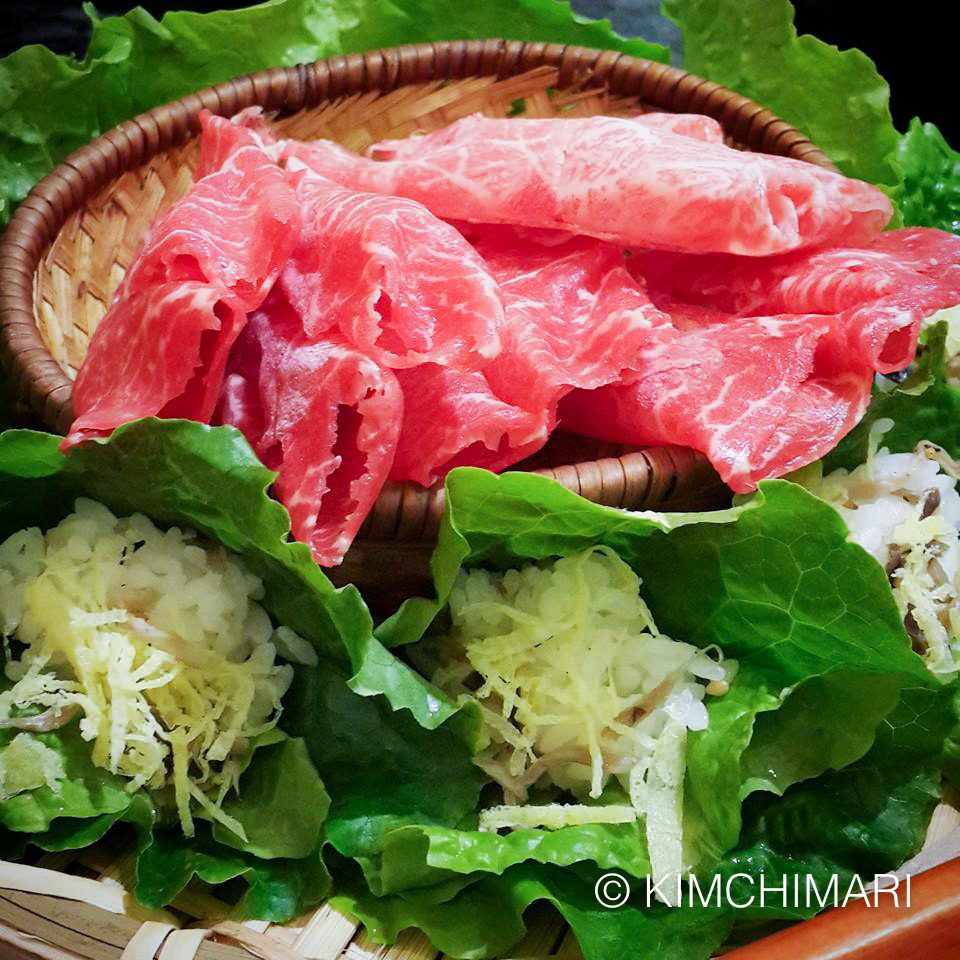
Unfortunately, I never got to explore the topic of the different leaves used for Ssam during my stay in Korea. But as I was writing my post on Ssambap recipes recently, I realized that it would be great to share all the different ssam materials that Koreans use to make their ssambap with. So I did a bit of research and had fun finding out what each of the greens were.
I kind of knew what they were called in Korean but for some of them, I had no idea if they only grow in Korea or if it was something that we could possibly grow here in the US or at any other country for that matter.
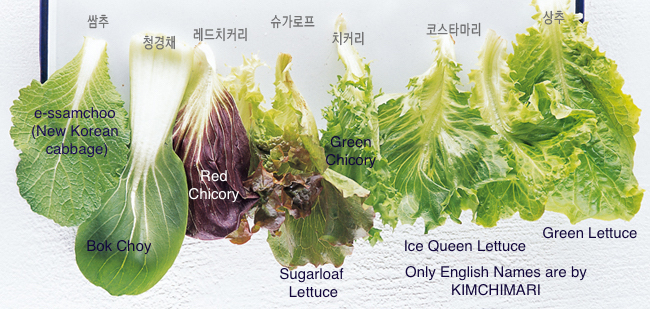
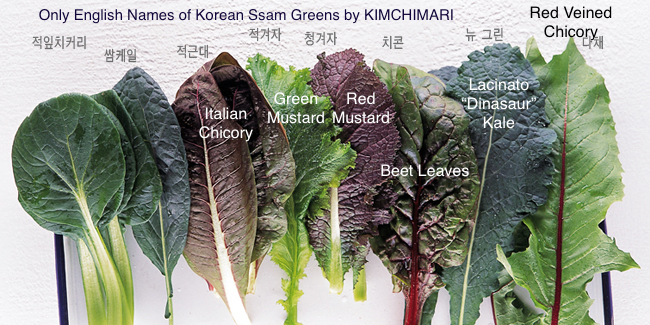
The pictures above has all the different greens used for Korean Lettuce Wraps that are labeled in Korean. And I wrote their equivalent English names on top of each.
NOTE – the above two photos are NOT mine.
** It was very hard to find where this image originally comes from. Koreans are not very strict about copyrights so they don’t specify where they got it from. Anyway, I found two sources (1st, 2nd).
BTW, the above picture has a few incorrect labels or pictures.
Corrections regarding the image –
- SsamKale (Baby Collard Greens) in the 2nd picture is incorrect. I know this because if there is one veggie I remember from Korea, it is SsamKale (쌈케일). This was my favorite. No strong bitterness (which many Chicory varieties often have) but just a great mild, slightly sweet flavor that works well with any kind of meats. I always wondered what this variety was…and now, after extensive research, I found it!!! The hint came from some Korean documents that referred to SsamKale as also 콜라드 (“collaad”). Could it be?? Who would have thought that good ol’ collard greens would be repackaged and used in Korean cuisine this way? All this time, I thought it must have been some type of Kale variety. Well… surprise!!! I am definitely going to try to grow them next year – it should be fun. UPDATE 2019 – I indeed bought some ssamkale seeds in 2019 and planted them. They grew really well and I really enjoyed them!
SsamKale (Collard Greens) growing in my garden - Green Mustard (청겨자) and Red Mustard (적겨자) labels are switched in Varieties B.
- Red-veined Chicory is incorrectly labeled as 다채.
I’m also going to organize it in a table below –
| English | Korean |
|---|---|
| Perilla | 깻잎 (Kkaennip) |
| Crown Daisies | 쑥갓 (ssukat) |
| Tatsoi | 비타민 (bitamin)or 다채 (dachae) |
| Baby Collard Greens | 쌈케일 (ssam kale) |
| Italian Chicory (Rossa Di Treviso) | 적근대 (jeok geundae) |
| Green Mustard | 청겨자 (cheong gyeoja) |
| Red Mustard | 적겨자 (jeok gyeoja) |
| Beet Leaves | 치콘 (chikon) |
| Lacinato "Dinosaur" Kale | 뉴그린 (newgreen) |
| Red Veined Chicory | 적치커리 (jeok chikeori) |
| New Korean Cabbage | 이-쌈추 (e-samchoo) |
| Bok Choy | 청경채 (cheong gyeongche) |
| Red Chicory | 레드치커리 (red chikeori) |
| Red Leaf Lettuce | 적상추 (jeok sangchu) |
| Sugarloaf Lettuce | 슈가로프 (suga-loph) |
| Green Chicory | 치커리 (chikeori) |
| Ice Queen Lettuce | 코스타마리 (costamari) |
| Green Lettuce | 청상추 (cheong sangchu) |
How to grow your own Ssam in your garden
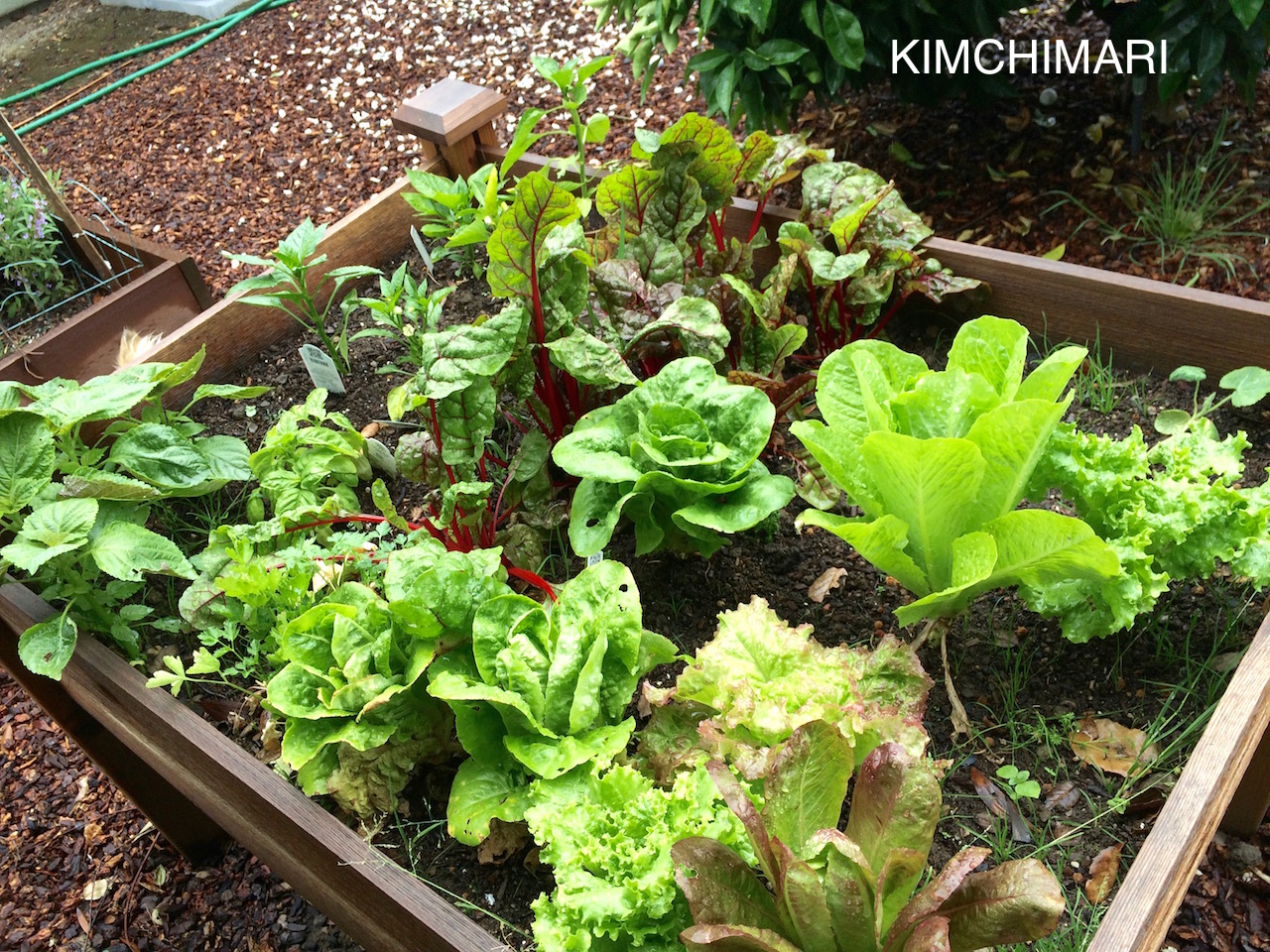
This is a picture that I took back in April. Here, I have planted the following (check out my Amazon store for Korean vegetable seeds including some below) – btw I’m an affiliate.
- Perilla – easily grown from seeds. They are of the mint family and they reseed and come back following year. Plant in spring outside after frost for best results. Grows easily in pots too. Needs good moist soil and sunny or part shade location. Pinch them off like basil on top and they will double.
- Crown Daisy – easy to grow from seeds. They are also not too hard to grow. They don’t reseed easily like Perilla but you can collect the seeds once the blooms fade. Also called Chrysanthemum leaves, these vitamin-rich cabbage/brassica family plants do well in cool weather & in cool or solar greenhouses but also fine in my hot California summer (as long as you water thoroughly).
- Romaine lettuce, Red and Green Leaf lettuce, and Beet leaves were all bought from my local nursery. I’m pretty sure you can also buy Chicory, Mustard and Dinosaur Kale or their seeds at least.
- Ssam Kale – buy Collard Greens seeds and grow them but harvest when the leaves are quite young.
So, just to compare, this is a closeup picture of Ssamkale that I found from a Korean blog –
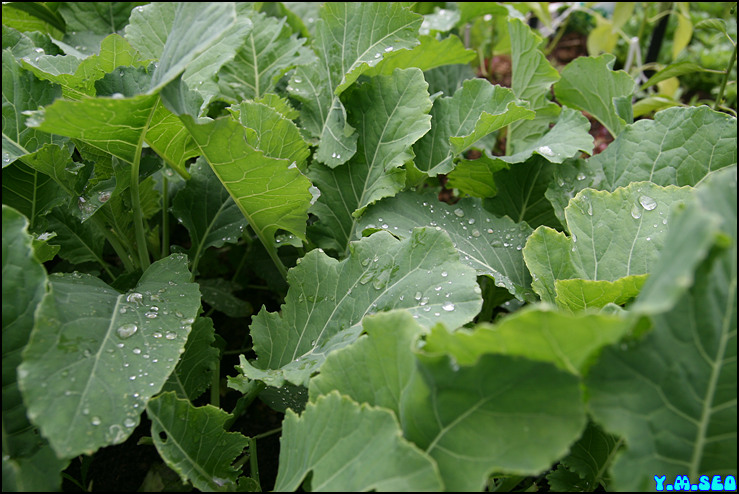
And then, here’s a picture of collard greens grown in the US. I know there are several varieties of collard greens and I have not gone as far as identifying which particular variety..If anyone can tell me, I would love to hear more about it!
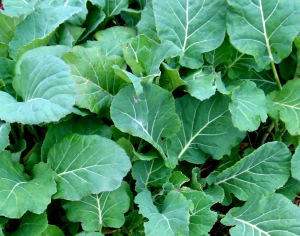
Besides, the ones I have listed above, one ssam green called e-ssamchoo caught my interest because it is an entirely novel plant, developed by Prof. Lee Kwanho in Korea. This novel plant (patented 2003) was developed by crossing chinese cabbage and regular cabbage to produce an ideal green for Korean ssam.
Pretty awesome!! Right?
There are also some additional leafy vegetable used for Korean Lettuce Wraps that is not in the picture above and here they are:
- Korean/Napa Cabbage (배추 Baechoo) – use young, fresh yellow inner leaves for the sweetest flavor.
- Kelp (다시마 Dashima) – use tender kelp. Best served with chogochujang instead of ssamjang.
- Gomchee (곰취): grows in Eastern Asia mostly and is known as Fischer’s Ligularia. It is of the Aster family and is a perennial plant. Blanch before using since this is pretty tough.
Fresh Korean gomchee (곰취) “Fischer’s Ligularia” Blanched Korean gomchee (곰취) “Fischer’s Ligularia” for Korean Ssambap
Well, hope you get to explore your local market or home garden and make some great ssam with all the different greens! And if you have a favorite that I did not mention here, I would love to hear from you!!
Have fun!!
JinJoo
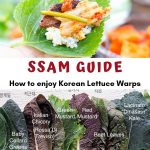
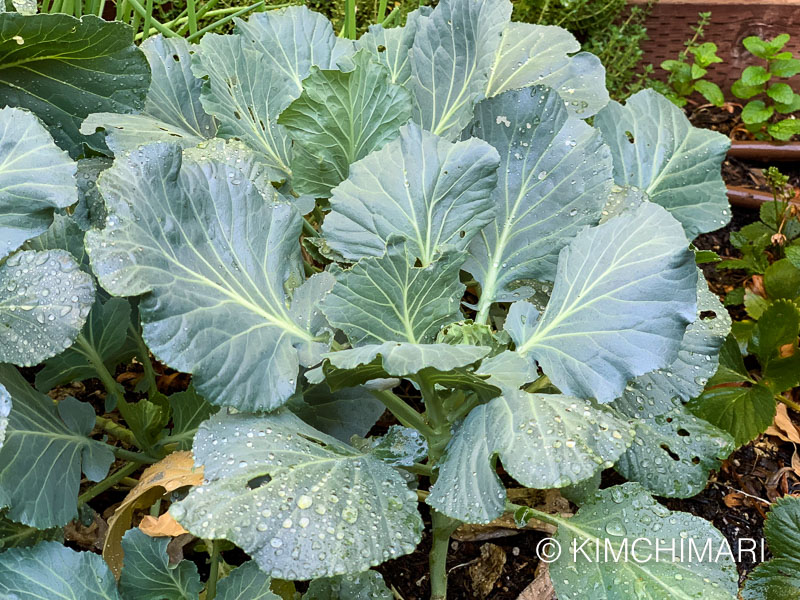
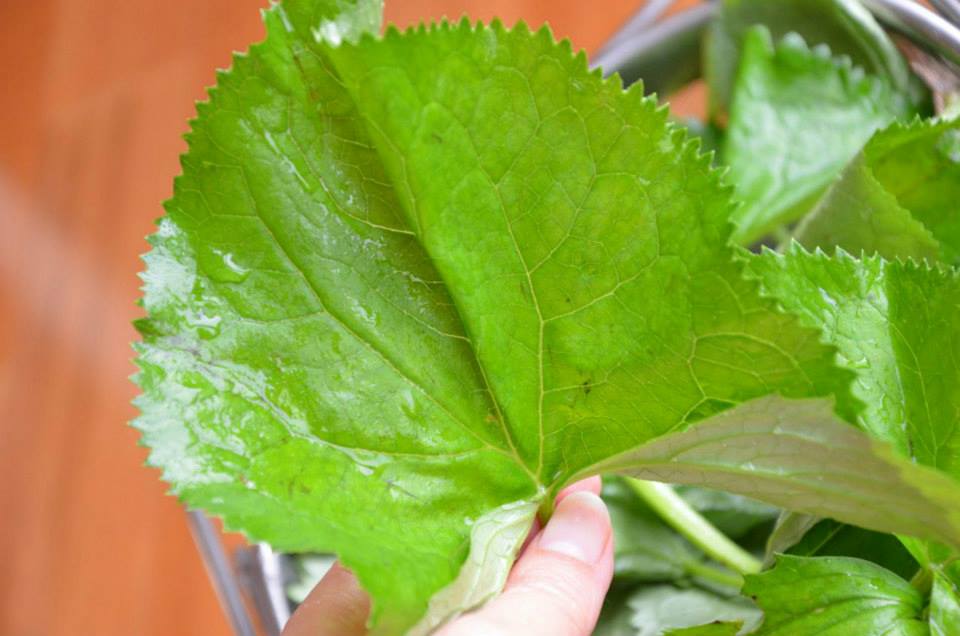
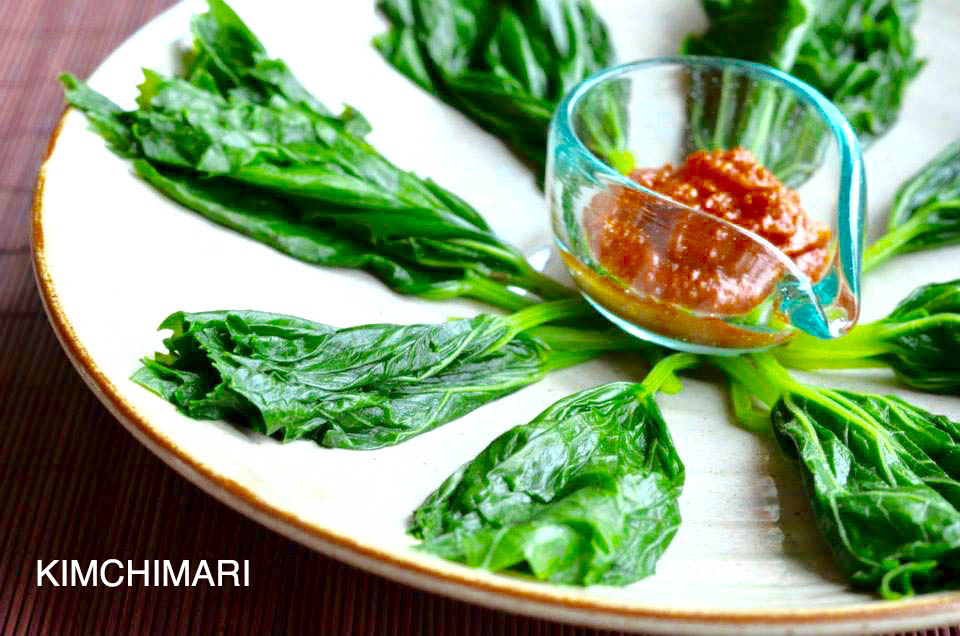
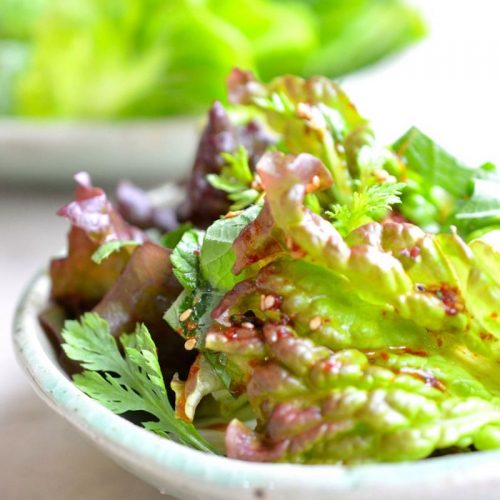
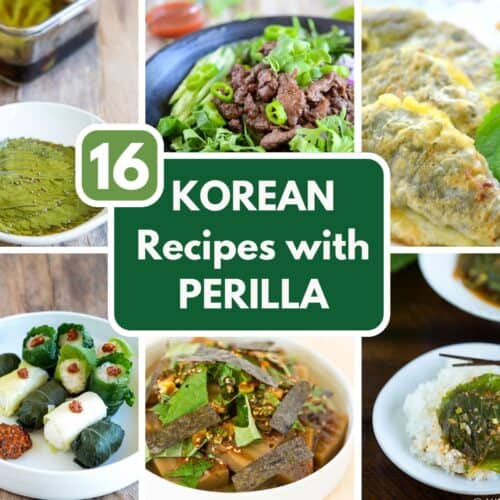
















This is truly one of my favorite meals but I had no idea the breadth of wrapping that could be used. Thanks for your hard work and my waistline thanks you also
I’m so glad you found the article helpful and interesting. Isn’t it soo fun? Enjoy!
This is so very helpful! Thank you!
Thank you for finding it helpful!! Have a good day!
I have beautiful big green perilla leaves growing in my garden right now. So far no animals have feed on it like some of my other plants……And want to try using and preserving them…….your article was sent with perfect timing. Got some plant at my local H Mart……..But will try to harvest the seed this year. Thank you for all the great information !
Oh YAY!! Yes, not many animals like Perilla – in Korea it is sometimes used to deter deers from coming into the crop field. So in order to harvest Perilla seeds, let the seed pods become brown on the plant (like my picture) and then cut the whole stem. Then put them in a grocery plastic bag with the stems sticking out and the seed pods in the bag. Hold the stems and shake the seeds off while in the bag, this way you won’t have seeds all over your floor! Most of them will come out into the bag. You may still have some left in the pods which you will need to peel to get them out. Good luck!!
Thanks a lot !!!! Several of that we only know korean name and we can not find seeds. This post will be so helpful
Glad my research was helpful!! Yes, I only knew their Korean name before too. Enjoy~
I love your blog so much! Thank you for your delicious recipes and posts like this one, they’re so informative. I’d never be able to find this info on my own. 고마워요!~^^
You are very welcome!! Your comment makes all the hard work totally worthwhile~ Thank you!